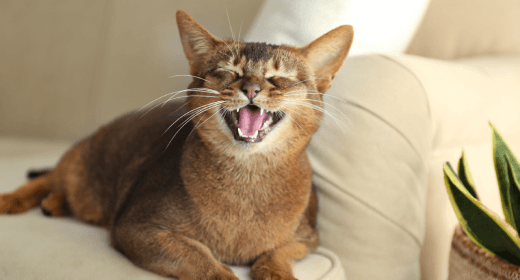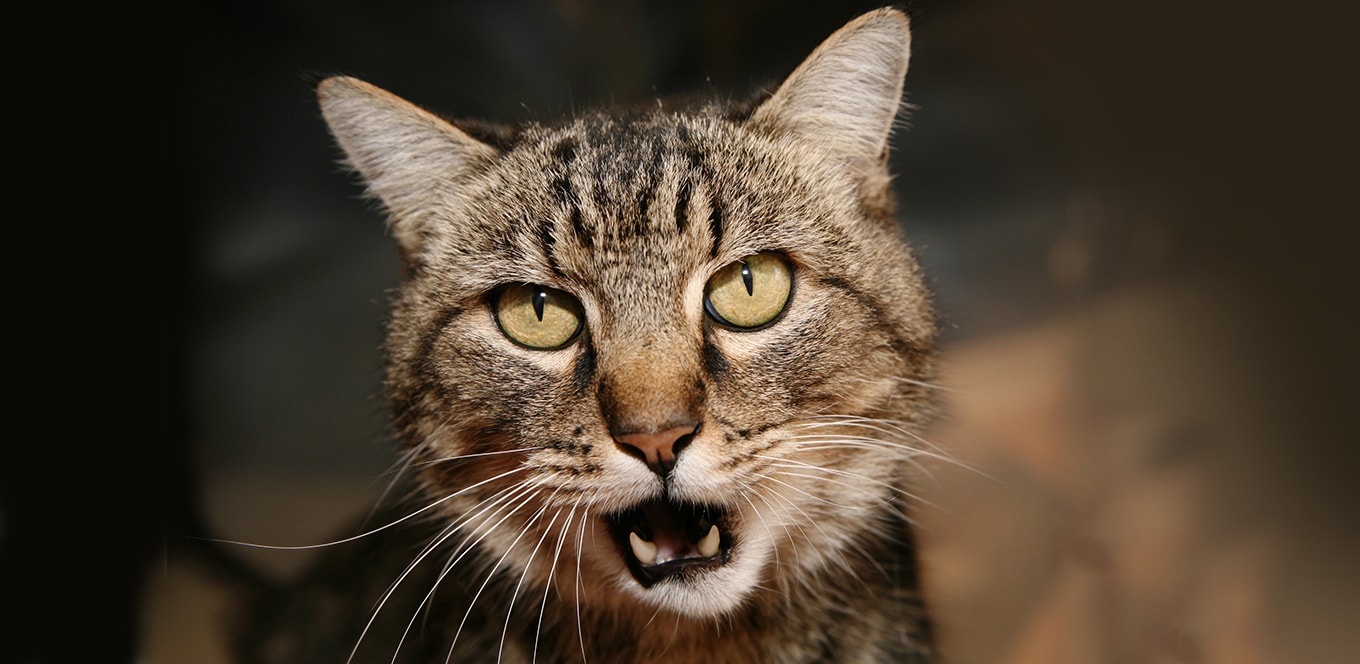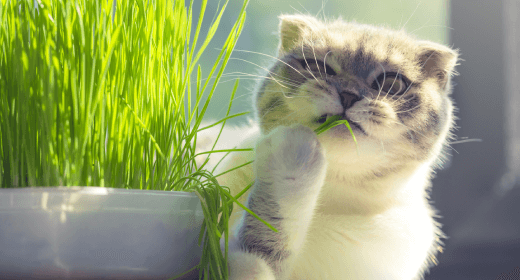

Have you ever wondered about the mysteries behind a cat's purr? It is not just a simple sound, but a blend of feline physiology at work. Cats achieve their signature purr through rapid contractions and relaxations of their laryngeal muscles, around 150 times per second. This creates that familiar, soothing and resonant sound we all adore. And as your cat takes each breath, the airflow caresses these vibrating muscles adding more depth to its purr. In this blog, we will look into the secrets behind this enchanting feline phenomenon.
Purring is a feline’s versatile tool of communication. Sure, cats purr when they are happy and comfy, but they can also purr when they are stressed, in pain, or even when they are hungry – it is like a cat crying for some attention. And here is a fun fact: mama cats purr to bond with their kittens, and kitten sounds are indicators of the little ones telling mom everything is fine.
Let us dive into the details of different cat sounds because they might just be trying to tell you something important.
Cats are like mysterious little furballs, and their purring adds another layer to the enigma. So, what exactly are they trying to convey when they turn on the purr engine?
When your cat is in its happy place – curled up on your lap or basking in a sunbeam – that gentle purring is often a sign of pure contentment. In cat language, it means, 'Life is good right now.'
Cats are known for their independent streak, but when they snuggle close and start to purr, it is a clear sign of love and bonding. It is a cat’s way of saying, 'You are my favourite human, and I adore you.'
Ever noticed your cat purring when you are in the same room but cannot see her? That is her way of announcing her presence, like a cat crying as a GPS locator, 'Don’t worry, I am nearby.'
It is not all sunshine and rainbows. Cats may also purr when they are in pain or discomfort, which can be akin to a kitten sound or cat cry, meaning something is not quite right.
Cats are remarkable self-healers, and purring may have therapeutic effects. The vibrations produced during purring may promote the healing of bones and tissues. I is their natural way of saying, 'I will make myself better,' and it is not unlike the comforting kitten sound that a mother cat makes to communicate love to her babies.
That ecstatic purring when you stroke cats’ fur or tickle them? It is the feline version of laughter. They are loving every moment of your attention, and their purr is a joyful response.
Cats have a unique ability to use purring as a stress-relief mechanism. When faced with a tense situation, they may start to purr to calm their frayed nerves. It is like their built-in stress buster.
Sometimes, it is all about the food. Cats can be quite vocal when they are hungry, and this may include the sound of a cat crying. When being loud, it could mean that the cat said it is dinnertime. It is like a polite request for a meal.
With this information up your sleeve, the next time your furry friend starts to purr take a moment to decode the message. It is like having a heart-to-heart conversation in your cat’s language!
If your feline friend seems to be a chatterbox, you might be wondering what is behind your cat’s meowing. Cats are quite expressive through their meows, and the reasons can vary. A cat’s meow sound may be to seek attention, express hunger, combat loneliness, or signal stress or discomfort. Older cats may meow more due to cognitive changes, and sometimes, boredom can lead to cats meowing excessively. Paying attention to the context and your cat's specific meowing patterns can help you understand its needs and ensure its well-being.
Cats are vocal creatures, and they have an impressive range of sounds to express themselves. Here are five of the most common cat sounds and what they typically mean.
Meowing is an all-purpose communicator in cat language. Cats meow to get your attention, ask for food, or simply say hello. The tone and intensity can convey their emotions, from friendly greetings to a cat crying for urgent demands.
In cat language, this is a clear sign of displeasure or fear. When a cat hisses, it is a warning to back off, and it is best to respect their boundaries.
This quirky cat sound often happens when a cat spots a bird or other prey through a window. It's like their way of expressing excitement and frustration at not being able to catch it.
This kitten sound is a signal that your cat is feeling threatened or territorial. It is a low, guttural sound meant to deter potential intruders.
This is the sound of a cat crying, meaning it is mating season. This cat crying sound is also heard when an unspayed female is in heat. It is a cat's way of announcing its presence and seeking a mate.
Understanding these sounds can help you connect better with your feline friend and respond to its needs and emotions appropriately.
A cat’s meow sound can mean various things, from seeking attention or food to expressing discomfort or simply saying hello.
A cat’s meow sound may be due to hunger, discomfort, illness, or anxiety. It is essential to investigate the cause and address its needs.
You can encourage your cat to meow more by engaging in interactive play, offering treats, and spending quality time with it. Building a strong bond can lead to more vocal communication through your cat’s meow sound.
In cat language, purring can signify contentment. But in certain cases, it can also indicate pain, stress, or a desire for attention, depending on the context. Sometimes, it might even be confused with the sound of a cat crying when they are in distress.
Purring does not always mean your cat is happy. While it is often a sign of contentment, cats can also purr when they are in pain, anxious, or unwell.
Cats purr when cuddling to express comfort and contentment. It is their way of saying they enjoy the affection and feel safe with you.



fibre is a vital component in a cat's diet, categorised as soluble and insoluble. Soluble fibre, dissolving in water, regulates blood sugar and lowers cholesterol, while insoluble fibre adds bulk, aiding in digestive movement. Crucially, fibre remains undigested, with some types fermenting to produce short-chain fatty acids (SCFA). These SCFAs serve as a key energy source for the cells lining the intestinal tract, fostering a healthy gut environment. fibre for cats also promotes weight management by inducing a sense of fullness, preventing overeating.
Balancing fibre in cat food is crucial, as excess may lead to nutrient malabsorption. Monitoring fibre types and amounts is vital for optimal feline health, ensuring digestive regularity. Striking this balance supports longevity and vitality in cats, making fibre an indispensable element in their overall well-being.
Today, people are more aware of fibre and its role in their diet. Studies showing the beneficial effects of higher fibre levels in humans influence the way many people think about their own food and that of their pets. Some manufacturers now apply the recommendations of human nutritionists and make high-fibre diets for cats, but cats have a much shorter digestive tract than we do. And unlike humans, cats are carnivorous, so their nutritional needs are better satisfied with meat rather than plant matter. Therefore, cats have different dietary needs than humans. For more than 60 years, companion animal nutritionists at IAMS™ have been studying diets to meet the special nutritional needs of cats.
The feline microbiome constitutes a diverse community of microorganisms, residing predominantly in the gastrointestinal tract. This intricate system of bacteria, viruses, and fungi significantly impacts a cat's health. It plays a crucial role in digestion, influencing nutrient absorption, supporting immune function, and even affecting behavioural patterns. The delicate balance within the microbiome is essential for the overall well-being of the cat, making it a key focus in understanding and optimising feline health.
When it comes to feline nutrition and gut health, the impact of fibrous foods on a cat's microbiome is driven by processes essential for maintaining gastrointestinal balance. Listed below are some interactions and their impact on your cat:
When cats consume fibrous foods, their gut microbiome undergoes a dynamic response, adapting to the influx of indigestible fibres.
Certain fibres for cats function as prebiotics, fostering the growth and activity of beneficial bacteria, such as Bifidobacteria and Lactobacillus, which are essential for gut health.
fibre fermentation by gut bacteria results in the production of short-chain fatty acids (SCFAs), including acetate, propionate, and butyrate.
SCFAs play a pivotal role in nourishing the cells lining the intestinal tract, contributing to mucosal integrity, nutrient absorption, and overall gut function.
fibre-induced fermentation also produces gases and by-products, influencing the pH of the gut environment, creating an environment that discourages harmful pathogens.
IAMS Company research shows the optimal crude fibre level for healthy cat’s ranges from 1.4% to 3.5%. At these levels, nutrient breakdown is maximised. In unique situations, such as hairballs, higher fibre levels may be beneficial.
An important characteristic of fibre is its fermentability, or how well it can be broken down by bacteria in the intestine. This breakdown produces short-chain fatty acids, which provide energy to the intestines. fibre varies in fermentability. fibre sources used in pet foods include cellulose, which is poorly fermentable; beet pulp, which is moderately fermentable; and gums and pectin, which can be highly fermentable. Research has shown that moderate levels of moderately fermentable fibre, such as beet pulp, provide the benefits of energy for the intestinal lining and bulk, without the negative effects of excessive stool or gas and, therefore, are beneficial in cat diets.
Incorporating high-fibre cat food into your feline’s diet offers various health benefits, contributing to their overall well-being. Here is a breakdown of the advantages and how they positively impact feline health:
High-fibre cat food promotes optimal digestive regularity in cats by adding bulk to the stool. This helps prevent issues such as constipation and ensures smoother bowel movements, contributing to overall gastrointestinal health.
The inclusion of fibre in cat food provides a feeling of fullness without adding excessive calories. This can be beneficial for weight management, as it reduces the likelihood of overeating and helps control calorie intake, supporting healthy body weight.
Increased fibre intake aids in controlling and reducing hairballs in cats. The fibrous content helps bind hair together, facilitating its passage through the digestive tract and minimising the risk of hairball-related issues.
fibre-rich cat food diets play a crucial role in managing diabetes in cats. The slow digestion and absorption of carbohydrates associated with increased fibre can help regulate blood sugar levels, providing better glucose control for diabetic cats.
Soluble fibre for cats, found in high-fibre foods, has cholesterol-lowering properties. By binding to cholesterol molecules and promoting their excretion, soluble fibre contributes to maintaining healthy cholesterol levels, supporting cardiovascular well-being in cats.
High-fibre diets are often recommended for cats with specific medical conditions, such as obesity, diabetes, or certain gastrointestinal disorders. The advantages of fibre, including weight management and blood sugar regulation, make it a valuable component in the overall treatment and management of these conditions.
While low-fibre cat food is recommended in certain cases, it is essential for cat parents to be aware of potential drawbacks that can impact their feline companion's health and well-being.
A diet low in fibre may contribute to constipation issues in cats as it lacks the bulk necessary for proper bowel movement regulation. This can result in discomfort for the cat and potential complications if not addressed promptly.
Low-fibre foods might compromise the overall efficiency of the cat's digestive system, potentially leading to inadequate nutrient absorption. This could impact the cat's overall health and vitality, making it crucial to monitor its digestive well-being.
While low-fibre diets are often associated with weight loss, they may also pose a risk of obesity if not carefully monitored. Cats might consume more to compensate for the reduced caloric content, emphasising the need for vigilance in managing portion sizes.
Cats on a consistently low-fibre diet may face challenges in obtaining a balanced array of essential nutrients, potentially leading to nutritional imbalances and health issues.
Being aware of these potential downsides helps cat parents make informed decisions about their feline’s diet, promoting overall feline well-being.
When choosing a pet food, fibre is an important consideration, but remember that the needs of cats are not the same as those of humans. A moderate level of moderately fermentable fibre, such as beet pulp, provides proven nutritional benefits for cats. Cat diets containing high levels of poorly fermentable fibre dilute calories and deprive cats of the nutrients they need.
All IAMS products are made with levels of moderately fermentable fibre needed to promote intestinal health. And all IAMS foods, such as IAMS ProActive Health™ Adult Original with Chicken, contain the moderately fermentable fibre system, which is the exclusive property of IAMS Company and is protected by U.S. Patent No. 5,616,569 for Pet Food Products Containing Fermentable fibres and Process for Treating Gastrointestinal Disorders.
Ensuring your feline companion meets their daily fibre requirements is crucial for their overall well-being. IAMS cat food offers a balanced and convenient solution to help achieve this goal. Here's a guide on maintaining your cat's daily fibre quota using IAMS:
IAMS cat food provides detailed nutritional information on the label. Check for the fibre content to understand how it contributes to your cat's daily requirements.
IAMS offers a range of cat food varieties, including formulas designed for specific needs such as weight control, hairball management, and digestive health. Select a variety that aligns with your cat's individual needs.
If you're introducing a new IAMS formula to your cat, make the transition gradual to allow their digestive system to adjust. This helps prevent any sudden changes in fibre intake.
Every cat has unique dietary needs. Consult with your veterinarian to determine the optimal daily fibre quota for your cat based on factors such as age, weight, and health conditions.
IAMS provides feeding guidelines on the packaging. Monitor and adjust portion sizes based on your cat's activity level and weight management goals to ensure they receive an appropriate amount of fibre.
IAMS offers both wet and dry cat food options. Combining both varieties can offer a well-rounded diet, ensuring your cat receives a mix of moisture and essential nutrients.
Regular veterinary check-ups help monitor your cat's overall health, including their digestive well-being. Discuss any concerns about fibre intake or dietary preferences with your veterinarian during these visits.
By incorporating IAMS cat food into your cat's diet and following these guidelines, you can provide nutritionally balanced and fibre-rich cat food that supports their digestive health and overall vitality.